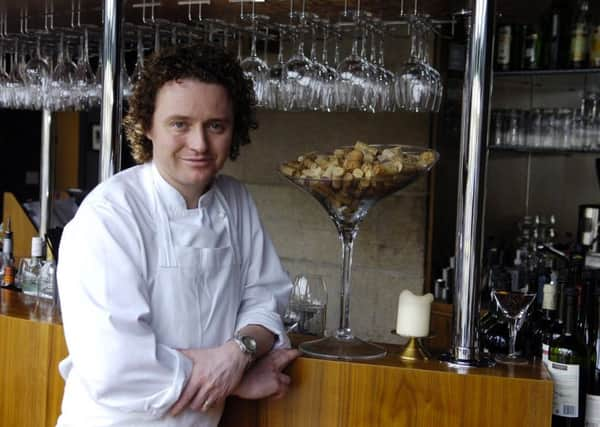Tom Kitchin: Cooking with spinach


Spinach has quite a distinctive, slightly bitter flavour, but if you prepare it in the right way and marry it with complementary, seasonal flavours, it’s extremely tasty. Ultimately, you have to start with the freshest produce. Look for bright, vibrant green leaves and avoid any bruising, tears or yellow foliage.
Spinach is most often served cooked, but I also like to enjoy it raw as it has quite a different flavour. If you’re going to eat it raw, you want to look out for the smaller leaves, which are ideal for salads as they have a slightly milder taste. If you’re cooking spinach, seek out the larger leaves as they stand up to this process better.
Advertisement
Hide AdAdvertisement
Hide AdStart out by being generous – many people are amazed by how much spinach can reduce when it’s cooked. The other thing to be really careful of is cooking time. Spinach has one of the shortest cooking times of all vegetables, so don’t be tempted to overdo it or it won’t be enjoyable to eat. If it’s the nutritional benefits you’re after, quick cooking is best too as the longer you cook it, the more these are reduced. Interestingly, cooking the leafy vegetable will reduce the levels of vitamin C and folate, but cooked spinach provides more vitamin A than raw. To ensure it’s still packed with nutrients, the best option is to steam, quickly blanch or speedily sauté your spinach. For me, variety is best. Enjoying a combination of raw and cooked will mean you get the most taste and health benefits.
Washing or rinsing spinach too much is another thing to be careful of. If you’re buying loose spinach – which I would recommend – it will need to be washed to remove dirt and grit, but take extra care to shake off the excess water and pat dry with kitchen paper or you’ll end up with wilted, soggy spinach.
Spinach is pretty versatile and can brighten up lots of dishes whether it’s a delicious side of buttered leaves served with a Sunday roast or whole fish, or a perfect addition to pasta or an egg dish.
Spinach Cooking Guide
Enjoy raw in salads.
Stir-frying spinach only requires as little as 1-2 minutes.
If you’re steaming spinach, I’d recommend 3-4 minutes and no more.
Roasting requires a little longer, but no more than 8-10 minutes.
Smoked Salmon and Spinach Lasagne
Serves four to six
For the béchamel sauce:
75g butter
75g plain flour
850ml milk
sea salt and freshly ground black pepper
Lasagne
25g butter
1 leek, trimmed, washed and cut into strips
400g baby spinach
2 garlic cloves, peeled and crushed
400g smoked salmon
300g Cheddar, grated
8-10 lasagne sheets
4 dill sprigs, roughly chopped, to garnish
Method
Heat the oven to 180C/Gas Mark 4. To make the béchamel sauce, melt the butter in a heavy-based saucepan, stir in the flour and cook for 1–2 minutes. Slowly stir in the milk and cook at a gentle simmer, stirring frequently, until the sauce thickens. Season with salt and pepper to taste. Set aside.
For the lasagne, melt half the butter in a heavy-based pan over a medium-low heat. Add the leek strips, season with salt and pepper and sweat gently for 2–3 minutes. Add the baby spinach leaves, a handful at a time, along with the garlic and cook for another minute or two. Drain off the excess liquid.
Use the rest of the butter to grease a large square or rectangular ovenproof dish. Cut the smoked salmon into small pieces, roughly 2cm square. Spoon a layer of the béchamel sauce over the bottom of the dish and layer a third of the lasagne sheets on top. Spoon half of the leek and spinach mixture over the lasagne, followed by a good third of the smoked salmon, then cover with a third of the remaining béchamel and sprinkle some cheese over the surface. Repeat the layers of lasagne, leek and spinach, smoked salmon, béchamel and cheese, then cover with a top layer of lasagne.
Advertisement
Hide AdAdvertisement
Hide AdSpoon the rest of the béchamel sauce on top and scatter over the remaining smoked salmon and grated cheese. Bake for about 45 minutes until the top is a deep golden colour. To check that the lasagne is cooked, insert a knife in the middle; it should meet with minimal resistance. Scatter the chopped dill on top of the lasagne and serve, with a crisp green salad on the side.
Plaice
prepared plaice per person (ask fishmonger)
50g butter
30 capers
juice of 1 lemon
handful of spinach
1 tbsb chopped parsley
50ml vegetable oil
flour to dust
pinch of salt
Method
Dust the plaice with flour and brush off any excess. Season with salt and, in a frying pan, fry the top side off in vegetable oil before cooking the down side for 5-6 minutes. Being careful, turn over the plaice and roast in the pre-heated oven at 180C/Gas Mark 4 for 4-5 minutes. Finish the fish in the pan with butter, lemon juice, parsley and capers, add the spinach to wilt, and serve.